Sambong
Sambong (Blumea balsamifera L.)
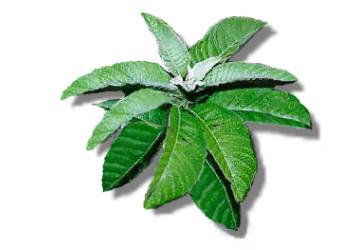
Sambong (scientific name: Blumea balsamifera) is an amazing medicinal plant. Coming from the family of Compositae, it goes by several names locally. It is known in the Visayas as bukadkad and as subsob in Ilocos. The plant is a strongly aromatic herb that grows tall and erect. Its height ranges from 1.5 to 3 meters, with stems that grow for up to 2.5 centimeters. It is an anti-urolithiasis and work as a diuretic. It is used to aid the treatment of kidney disorders. The Sambong leaves can also be used to treat colds and mild hypertension. Since it is a diuretic, this herbal medicine helps dispose of excess water and sodium (salt) in the body.
Sambong is one herbal medicine (of ten) approved by the Philippine Department of Health (DOH) as an alternative medicine in treating particular disorders. This plant possesses a multitude of properties that make it worthy of the DOH approval. It functions as an astringent and as an expectorant, and has been found to be anti-diarrhea and anti-spasm. As an astringent, preparations made of sambong leaves may be used for wounds and cuts. It is also suggested to be incorporated to post-partum baths, as well as considerable immersion of particular body areas that are afflicted with pains caused by rheumatism. Its expectorant properties make it as a popular recommendation to be taken in as tea to treat colds.
Powdered Sambong leaves are available in 250 mg tablets at the DOH's Philippine Institute of Traditional and Alternative Health Care (PITAHC) Telephone # (632) 727-6199.
Sambong is one herbal medicine (of ten) approved by the Philippine Department of Health (DOH) as an alternative medicine in treating particular disorders. This plant possesses a multitude of properties that make it worthy of the DOH approval. It functions as an astringent and as an expectorant, and has been found to be anti-diarrhea and anti-spasm. As an astringent, preparations made of sambong leaves may be used for wounds and cuts. It is also suggested to be incorporated to post-partum baths, as well as considerable immersion of particular body areas that are afflicted with pains caused by rheumatism. Its expectorant properties make it as a popular recommendation to be taken in as tea to treat colds.
Powdered Sambong leaves are available in 250 mg tablets at the DOH's Philippine Institute of Traditional and Alternative Health Care (PITAHC) Telephone # (632) 727-6199.
Health Benefits of Sambong:
• Good as a diuretic agent
• Effective in the dissolving kidney stones
• Aids in treating hypertension & rheumatism
• Treatment of colds & fever
• Anti-diarrheic properties
• Anti-gastralgic properties
• Helps remove worms, boils
• Relief of stomach pains
• Treats dysentery, sore throat
• Effective in the dissolving kidney stones
• Aids in treating hypertension & rheumatism
• Treatment of colds & fever
• Anti-diarrheic properties
• Anti-gastralgic properties
• Helps remove worms, boils
• Relief of stomach pains
• Treats dysentery, sore throat
Preparation & Use:
• A decoction (boil in water) of Sambong leaves as like tea and drink a glass 3 or 4 times a day.
• The leaves can also be crushed or pounded and mixed with coconut oil.
• For headaches, apply crushed and pounded leaves on forehead and temples.
• Decoction of leaves is used as sponge bath.
• Decoction of the roots, on the other hand, is to be taken in as cure for fever.
• The leaves can also be crushed or pounded and mixed with coconut oil.
• For headaches, apply crushed and pounded leaves on forehead and temples.
• Decoction of leaves is used as sponge bath.
• Decoction of the roots, on the other hand, is to be taken in as cure for fever.
Silymarin
Silymarin - Milk Thistle (Silybum marianum)
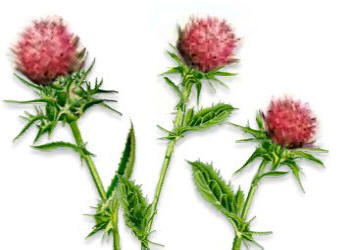
Silymarin is derived from Milk Thistle (seed extract from the flower of silymarin plant). The Milk thistle herb is a flowering plant of Silybum Adans genus, a member of the daisy family (Asteraceae). It grows mainly in North Africa, the Mediterranean region and the Middle East (now also grown in the U.S.) but is marketed and is widely available in the Philippines as a herbal liver supplement (silymarin capsules, trademark: Liveraide). Silymarin and milk thistle are frequently used interchangeably.
Laboratory experiments on animals (rats, baboons, dogs) shows that silymarin works by modifying hepatic cell membranes in a way that prevents liver toxins from entering the interior of the cells. The toxins that may damage the liver are expelled through the kidneys instead. Silymarin is a polyphenolic flavanoid consisting of three chemicals: silybin, silicristin and silidianin which are antioxidants that neutralizes and breaks down free radicals. When there is an existing liver damage, research shows that silymarin may help repair the damage and help regenerate new liver cells but is unlikely to help in the late stages of liver cirrhosis.
Many studies have been published on the health benefits of milk thistle and silymarin on humans but many are inconclusive or poorly done. Further studies are needed to fully appreciate the health benefits of silymarin on humans. However, anecdotal data suggests that it helps alleviate liver diseases and other aliments.
Since most commercial silymarin and milk thistle products are marketed as herbal supplements, they are not subjected to the same stringent standards imposed on prescription drugs. Their safety, purity and quality vary from brand to brand. In very rare instances, silymarin can cause headaches, upset stomach and joint pains. Silymarin is not recommended during pregnancy. Dozes over 1.5 grams a day may cause diarrhoea. It is recommended that you consult with your doctor or a health care provider before taking silymarin herbal supplements, liver supplements or any herbal medicine.
Laboratory experiments on animals (rats, baboons, dogs) shows that silymarin works by modifying hepatic cell membranes in a way that prevents liver toxins from entering the interior of the cells. The toxins that may damage the liver are expelled through the kidneys instead. Silymarin is a polyphenolic flavanoid consisting of three chemicals: silybin, silicristin and silidianin which are antioxidants that neutralizes and breaks down free radicals. When there is an existing liver damage, research shows that silymarin may help repair the damage and help regenerate new liver cells but is unlikely to help in the late stages of liver cirrhosis.
Many studies have been published on the health benefits of milk thistle and silymarin on humans but many are inconclusive or poorly done. Further studies are needed to fully appreciate the health benefits of silymarin on humans. However, anecdotal data suggests that it helps alleviate liver diseases and other aliments.
Since most commercial silymarin and milk thistle products are marketed as herbal supplements, they are not subjected to the same stringent standards imposed on prescription drugs. Their safety, purity and quality vary from brand to brand. In very rare instances, silymarin can cause headaches, upset stomach and joint pains. Silymarin is not recommended during pregnancy. Dozes over 1.5 grams a day may cause diarrhoea. It is recommended that you consult with your doctor or a health care provider before taking silymarin herbal supplements, liver supplements or any herbal medicine.
Anecdotal Health Benefits of Silymarin | Milk Thistle:
• Help improve liver function for those with cirrhosis of the liver and chronic hepatitis.
• Prevents inflammation of the liver
• Cure for Amanita phalloides mushroom poisoning
• Helps control blood sugar in patients with diabetes and cirrhosis.
• Helps lower cholesterol levels.
• Reduces growth of breast, prostate, cervical and skin cancer cells.
• Helps reduce fatty infiltration on the liver caused by toxins and alcohol.
• A strong antioxidant that helps fight free radicals (see Key to Healing).
• Not used to prevent hepatitis C, but used to minimize the damage caused by it.
• Non-toxic / no known overdose symptoms.
• Prevents inflammation of the liver
• Cure for Amanita phalloides mushroom poisoning
• Helps control blood sugar in patients with diabetes and cirrhosis.
• Helps lower cholesterol levels.
• Reduces growth of breast, prostate, cervical and skin cancer cells.
• Helps reduce fatty infiltration on the liver caused by toxins and alcohol.
• A strong antioxidant that helps fight free radicals (see Key to Healing).
• Not used to prevent hepatitis C, but used to minimize the damage caused by it.
• Non-toxic / no known overdose symptoms.
Tanglad
Tanglad | Lemon Grass (Andropogon citratus DC)
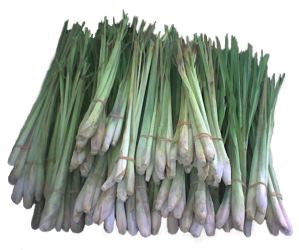
Tanglad or lemon grass is a commercially-viable plant that is cultivated mainly for the fragrance that it produces. It can be easily found in most Asian countries, and is widely cultivated in tropical areas. By nature, tanglad is a permanent or perennial plant, and the benefits of which are not restricted to its fragrance. The utility of tanglad basically lies in its leaves, where all the benefits are derived. What can be seen of this plant are mainly its leaves, which allows easy access to the main part that is needed in order to enjoy tanglad's health benefits. It constitutes most of what appears of this plant above ground, as the leaves grow up to one meter in length, and are flat in shape.
HEALTH BENEFITS OF LEMON GRASS | TANGLAD
Studies show that tanglad helps ease stomach discomforts and aids in lessening, if not totally curing, the pain caused by toothache and sprain. Lemon grass also displays anti-bacterial activities and anti-fungal properties, thus, eradicates ring worms. Like malunggay, lemon grass can also be applied to sprains for easy healing. In order to enjoy these benefits of tanglad, one needs to prepare a liniment. This can be done by chopping four ounces of the leaves and roots of tanglad and boiling them, along with fresh coconut oil. If it is infusion that an individual wishes to achieve, use one pint of water to boil the tanglad leaves with. The lemon grass plant may also serve as an insect repellant, particularly of mosquitoes. One can achieve an effect to this end either by applying liniment, or by placing crushed tanglad leaves in strategic places at home including the window sills. It is also an option to plant tanglad around the house so that placement of crushed leaves would no longer be needed.
Another health benefit which can be derived from tanglad, is the calming effect derived from its scent. Thus, lemon grass can aid an individual if such person is suffering from insomnia or stress. The plant also has therapeutic value, which allows it to be used by women who are suffering from menstrual problems or dysmenorrhoea, and from usual bouts of nausea. Tanglad also has cleansing properties, which makes it a good option to detoxify the various internal organs, like the liver. Lemon grass reduces the level of uric acid and of other toxins, as it detoxifies the body. This can result to better blood circulation and better digestion, as excess fats and cholesterol are cut down from the body. When taken in, tanglad affects the tissues in such a manner that there would be a significant reduction and avoidance of acne and pimples. Also, it tones the muscles and the tissues, and thus makes the skin firmer.
Like saluyot, exposure of an individual to the benefits of tanglad is greatly increased because of the nature with which it can be used. As saluyot can be taken in as part of one’s usual viand and dish, tanglad’s properties on the other hand, allows it to be used as food flavorings. Lemon grass is incorporated in a multitude of Asian cuisines and dishes, and in the Philippines it is even made part of commercial beverages. So aside from the oil that can be extracted from lemon grass leaves, the fluid that is obtained from the boiled leaves of this plant proves to have medicinal purposes as well. Such lemon grass leaves can also be used in its raw form by mixing directly with the food before it is served. Such dishes include, and are especially good, when the primary ingredient is fish or poultry. Besides the health benefits, tanglad balances the chili flavorings in dishes, which makes eating a more enjoyable experience.
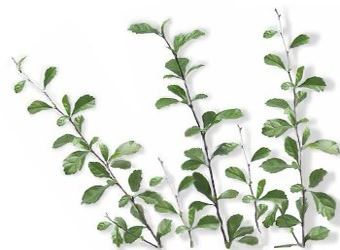

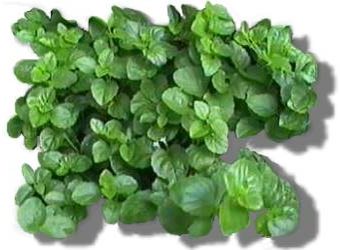
I have been cured HIV through Dr Utu African Traditional roots and herbs.
ReplyDeleteWhy so many people don't succeed in better health is because they have the belief that herbal medicines are primitive and outdated they took time ⌚ in thinking and having much doubt in herbs that can actually better their health naturally. Do you know that thinking and doubting won't solve your health problems?yes of course it won't solve it All you've to do is to stand up again and make the best move in your life. African herbs cures HIV, HSV, CANCERS, INFERTILITY, ASTHMA, PARALYSIS, DIABETES Try a reliable herbalist like Dr Utu and tell him your symptoms and feelings on;
drutuherbalcure@gmail.com
CALLING +2347032718477
WHATSAPP LINE +2347032718477
I started on COPD Herbal treatment from Ultimate Health Home, the treatment worked incredibly for my lungs condition. I used the herbal treatment for almost 4 months, it reversed my COPD. My severe shortness of breath, dry cough, chest tightness gradually disappeared. Reach Ultimate Health Home via their website at www.ultimatelifeclinic.com I can breath much better and It feels comfortable!
ReplyDelete